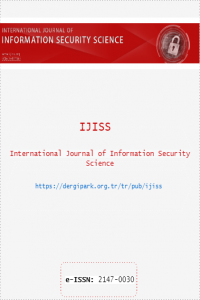A Study on OS Selection Using ANP Based Choquet Integral in Terms of Cyber Threats
A Study on OS Selection Using ANP Based Choquet Integral in Terms of Cyber Threats
___
- S. Galvin, Operating System Concepts, 4th Edition. Addison Wesley, Reading, MA, 1994.
- A.S. Tanenbaum, Operating Systems: Design and Implementation. Prentice Hall, Englewood Cliffs, NJ, E. Tolga, M. L. Demircan, C. Kahraman, “Operating system selection using fuzzy replacement analysis and analytic hierarchy process”, Int. J. Production Economics, 97, pp.89-117, 2005.
- G.D. Knott, A proposal for certain process management and intercommunication primitives. SIGOPS Operating Systems Review, 8(4), pp.7-44, S. Balli and S. Korukoğlu, Operating System Selection Using Fuzzy Ahp And Topsis Methods, Mathematical and Computational Applications, (2), pp.119-130, 2009.
- S. Jharkharia, R. Shankar, “Selection of logistics service provider: an analytic network process (ANP) approach”, Omega, 35, pp.274-289, 2007.
- S. Boran, K. Goztepe and E. Yavuz, “A study on election of personnel based on performance measurement by using analytic network process (ANP)”, IJCSNS International Journal of Computer Science and Network Security, 8(4), 2008.
- C. W. Chang, C.-R. Wu, C.-T Lin, and H.-L. Lin, “Evaluating digital video recorder using analytic hierarchy Information Sciences, 177(16), pp.3383-3396, 2007. network processes”,
- T.L. Saaty, The Analytic Hierarchy Process, McGraw-Hill, Inc., New York, USA, 1980.
- T.L. Saaty, Decision making with dependence and feedback: the analytic network process, RWS Publications, Pittsburgh, 1996.
- T.L. Saaty, “Fundamentals of the analytic network process”, Kobe, Japan: ISAHP, 1999.
- A. B. McBratney, O.A. Odeh, “Application of fuzzy sets in soil science: fuzzy logic, fuzzy measurements and fuzzy decisions”, Geoderma 77, 113, 1997.
- H. J. Zimmermann, “Fuzzy Set Theory and its Applications”, London, 1994. Academic Publishers,
- C.H. Liu, G.H. Tzeng, and M.H. Lee, “Improving tourism policy implementation-the use of hybrid MCDM models”, Tourism Management, 33(2), pp.239-488, 2012.
- J.L. Yang and G.H. Tzeng, “An integrated MCDM technique combined with DEMATEL for a novel cluster-weighted with ANP method”, Expert Systems with Applications, 38(3), pp.1417-1424, 2011.
- S. Boran and K. Goztepe, Development of a fuzzy decision support system for commodity acquisition using fuzzy analytic network process, Expert Systems with Applications, 37, pp.1939-1945, 2010.
- T. L. Saaty, “The analytic hierarchy and analytic network measurement processes: Applications to decisions under Risk”, European Journal of Pure and Applied Mathematics, 1 (1), pp.122-196, 2008.
- T.L. Saaty, L.G. Vargas, “Diagnosis with Dependent Symptoms: Bayes Theorem and the Analytic Hierarchy Process”, Operations Research, 46, pp.491-502, 1998.
- C. Kahraman, T. Ertay, G. Buyukozkan, “A fuzzy optimization model for QFD planning process using analytic network approach”, European Journal of Operational Research, 171 (2), pp.390-411, 2006.
- M. Sugeno, “Fuzzy measures and fuzzy integrals: a survey, in: M.M. Gupta, G.N. Saridis, B.R. Gaines (Eds.), Fuzzy Automata and Decision Processes”, North-Holland, Amsterdam, pp. 9-102, 1977.
- M. Sugeno, “Theory of fuzzy integrals and its applications”, PhD Thesis, Tokyo Institute of Technology, 1974.
- M. Sugeno and T.Terano, “A model of learning on fuzzy information”, Kybernetes 16(3), pp.157-166, L. Berrah, G. Mauris and J. Montmain, “Monitoring the Performance Aggregation”, Management Science, 36, pp.340-351, 2008. Integral Based The International Journal of
- T. Demirel, N. Ç. Demirel, and C. Kahraman, “Multi- criteria Choquet Integral”, Expert Systems with Applications, (5), pp.3943-3952, 2010. Selection Using
- P. Meyer, M. Roubens, “On the Use of the Choquet Integral with Fuzzy Numbers in Multiplecriteria Decision Support”, Fuzzy Sets and Systems, 157, pp.927-938, 2005.
- H. H. Tsai, I. Y. Lu, “The Evaluation of Service Quality Using Generalized Choquet Integral”, Information Sciences, 176, pp.640-663, 2006.
- Z. Wang, G.J. Klir, Fuzzy Measure Theory, Plenum Publishing Corporation, New York, 1992.
- E. Takahagi, “On IdentiŞcation methods of λ-fuzzy measures using weights and λ”, Japanese Journal of Fuzzy Sets and Systems, vol.12, No.5, pp.665-676, K. Ishii and M. Sugeno, “A model of human evaluation International Journal of Man-Machine Studies 22, pp.19-38, 1985. using fuzzy measure”,
- M. Grabisch, T. Murofushi, M. Sugeno, “Fuzzy Measures and Integrals”, Physica-Verlag, New York, T.L. Saaty and L.G. Vargas, “Decision Making with the Analytic Network Process”, Springer, Pittsburgh, USA, 2006. APPENDIX A
- INTERNATIONAL JOURNAL OF INFORMATION SECURITY SCIENCE Kerim GÖZTEPE, Vol.1, No.2
- Yayın Aralığı: Yılda 4 Sayı
- Başlangıç: 2012
- Yayıncı: Şeref SAĞIROĞLU
Notes on Bent Functions in Polynomial Forms
Onur Kocak, Onur Kurt, Neşe Öztop, Zülfükar Saygı
Muhammad Ashraf1and Barıs¸ B ¨ulent Kırlar1,2
A Study on OS Selection Using ANP Based Choquet Integral in Terms of Cyber Threats
Anonymous RFID Authentication for Cloud Services
Mehmet Kiraz, Muhammed Bingöl, Süleyman Kardaş, Fatih Birinci
